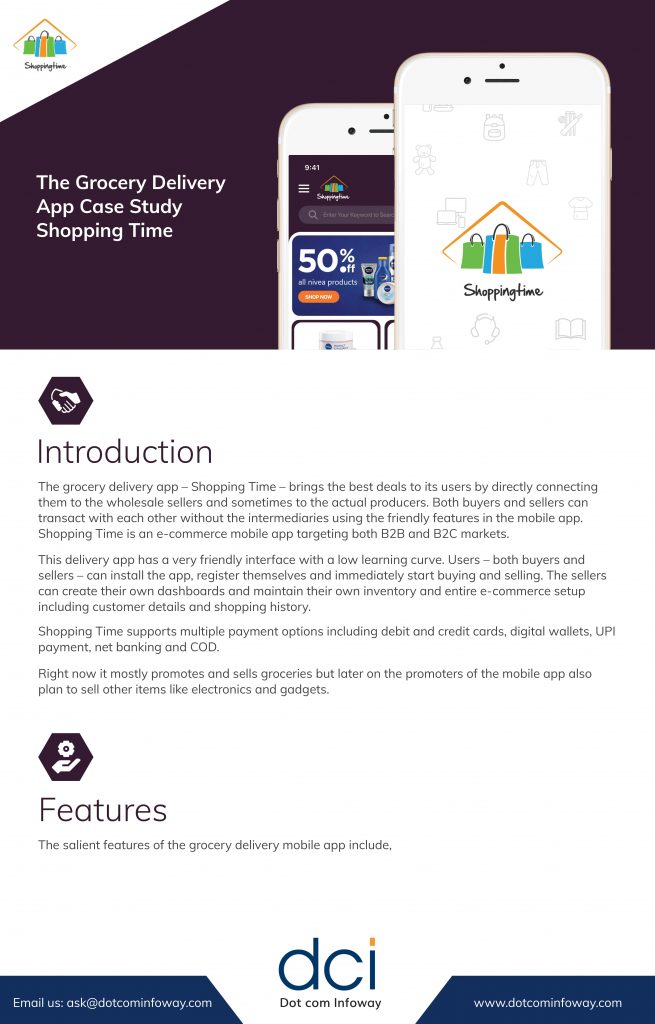The Grocery Delivery App Case Study – Shopping Time
Introduction
The grocery delivery app – Shopping Time – brings the best deals to its users by directly connecting them to the wholesale sellers and sometimes to the actual producers. Both buyers and sellers can transact with each other without the intermediaries using the friendly features in the mobile app. Shopping Time is an e-commerce mobile app targeting both B2B and B2C markets.
This delivery app has a very friendly interface with a low learning curve. Users – both buyers and sellers – can install the app, register themselves and immediately start buying and selling. The sellers can create their own dashboards and maintain their own inventory and entire e-commerce setup including customer details and shopping history.
Shopping Time supports multiple payment options including debit and credit cards, digital wallets, UPI payment, net banking and COD.
Right now it mostly promotes and sells groceries but later on the promoters of the mobile app also plan to sell other items like electronics and gadgets.
Features
- Complete shopping cart management giving an Instacart experience to the promoters and sellers.
- Options to create special offers for both B2B and B2C customers.
- Facilitates product returns and refund options.
- Delivery charge calculation & recalculation according to the distance between the pickup and the drop locations.
- Cross-selling and up-selling facilities.
- Complete shopping cart management features for the sellers.
- Unlimited order histories for sellers.
- Notification facility for customer engagement.
- Seamless UI for one-tap shopping.
- Login using social media accounts.
- Ability to sell product samples.
Challenges
This project came with its own unique set of challenges. Along with the fact that the promoters needed an Instacart like app development, they needed a grocery app development solution that would work across the platforms and eventually would become the best online grocery shopping app in India. Some of the challenges included,
- Special sections for B2B customers where they could manage their entire catalogue of items.
- A seamless online shopping app UI to facilitate buying and selling with minimum effort.
- Deliver a 100% e-commerce user experience needed for the online grocery app.
- Integration with the real-time mapping data to calculate and recalculate delivery charges according to the distance to be covered.
- The ability to showcase exclusive offers based on the buying history of the customers.
- Up-selling and cross-selling sections of items based on the buying history of the customers.
How we took up the challenge
Being one of the premier commercial app development companies in the country, we wanted to present a grocery app development solution that would be rewarding for all the stakeholders. We understood that the client could have used a readymade grocery app but they wanted to create a unique experience as well as a niche for themselves. We were ready to take on the challenge because we have the wherewithals including technology, experience and an expansive understanding of the shopping cart app market worldwide.
We decided to use the following technology stack to build the app:
React Native, Node.js, MongoDB
User experience was one of the biggest challenges because ultimately, the success of every shopping cart app depends on how easy it is for both the customers and the sellers to use the interface. Technology in this case must be a facilitator rather than something to be learned separately. The interface needed to be such that both the major stakeholders – buyers and sellers – who come from non-technological backgrounds, should be able to install the app, go through the initial setup, and start selling and buying immediately. All the tools that they need, must already be there within the interface. We are happy to state that our UI design was able to achieve that.
Another challenge was calculating and recalculating delivery charges based on the distance to be covered. The mapping API was used to fetch distance data and then map it with the price per unit added by the seller based on his or her agreement with the delivery service.
Results
We were able to design, develop and deploy the app within the stipulated time. Both customers and sellers are reaping the benefits of this app that can be downloaded and installed from Google Play. The client is quite happy with the solution that we provided.

